Catching Winter Catfish (Complete Cold-Weather Guide)
Leave a comment after this article and let’s talk more about catfishing. I’d love to read your feedback.
Most people seem to associate catfish completely to warm weather and assume they just aren’t biting in the winter. Some people even assume catfish hibernate in the winter and bury themselves in the mud until spring.
To catch catfish in winter, focus on deep, slow-moving waters where catfish retreat for warmth and stability. Use scented baits like cut fish or chicken livers, and be patient, as catfish are less active and slower to bite in cold temperatures.
Let’s dive a little deeper into this topic. Winter catfish angling can be better than summer fishing if you do it right. Winter catfish are easier to locate than summertime catfish. Catfish are very sensitive to water temperature and will do everything in their power to find the warmest water in the lake or river.
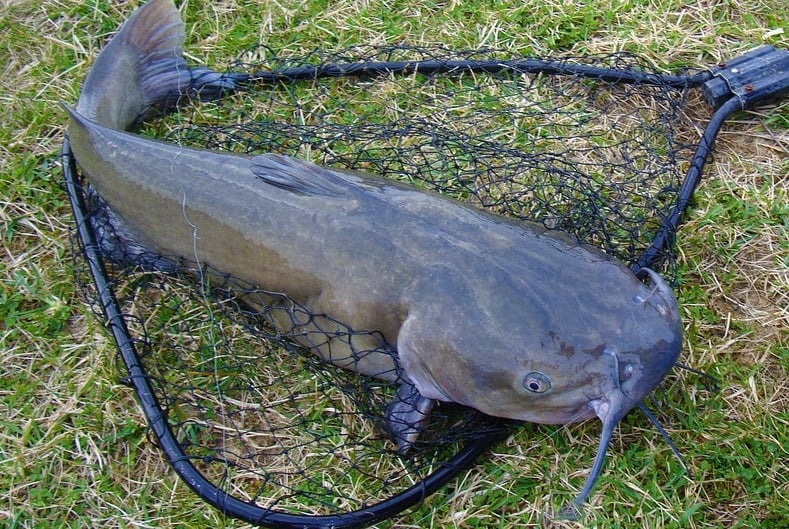
Almost always, the warmest water in a lake or river will be deep “wintering” holes. These are spots significantly deeper than any other bottoms nearby. Catfish will congregate in these holes by the hundreds.
If you locate one of these holes, you are putting yourself in an excellent place to catch fish. I would say on a given lake, there could be anywhere from 2-30 distinct wintering holes.
Almost every catfish in that lake will spend their winter in and very close to one of those holes. This means that 95%+ of a lake or river is completely void of catfish during the winter. As a result, finding catfish is the real game. Catching a lot of catfish becomes easy after that.
Table of Contents
Catching Winter Catfish
Table: How to Catch Winter Catfish
| Aspect | Description |
|---|---|
| Water Temperature | Focus on deeper waters where temperatures are more stable. Catfish tend to be less active in cold water and prefer stable environments. |
| Bait Selection | Use bait that emits strong scents, like cut bait (e.g., shad or herring). Live bait can also be effective in attracting lethargic catfish. |
| Fishing Technique | Employ a slow and patient approach. Since catfish are less active, a slower bait presentation is often more successful. |
| Location | Target deep wintering holes, deep river bends, holes near dam tailwaters, and deep pools where catfish congregate in cold months. |
| Time of Day | Fish during the warmest part of the day, typically midday, when the water temperature may rise slightly and increase fish activity. |
| Tackle | Use a heavier setup to handle the larger catfish typical of winter and to manage heavier weights for deep-water fishing. |
| Patience | Be prepared for a slower pace of fishing. Winter catfish are less active, so bites may be less frequent and require more waiting. |
Winter vs. Summer
Despite the commonly held belief that catfish are easiest to catch in the summer, I would argue the opposite is true. During the summer, catfish are pretty evenly dispersed throughout a lake or river.
Yes, your bait may land near one catfish but the next closest catfish may be 20 yards away or further.
During the winter, catfish bunch up into very large congregations. Once water temperatures consistently dip beneath 60° F, catfish move into the main body of the water and seek out their wintering grounds.
Not just catfish, but almost all freshwater gamefish and bait will seek out these wintering grounds since this is where they can locate the warmest water furthest removed from the cold, surface of the lake.
95% of the lake will hold zero fish but if you can locate those 5% zones, the wintering holes, you will have easy access to every catfish in the lake.
Catfish fishing doesn’t get any easier than this. The hardest part is just locating the prime wintering holes.
Best Time to Catch Catfish in the Winter
The best time to catch catfish in the winter is usually during the warmer parts of the day, when the water temperature is slightly higher. Catfish are more active and will be more likely to bite during these periods. However, it is important to note that the best time can vary depending on the specific location and weather conditions.
Locating Wintering Holes
In large lakes, a great place to find wintering holes are near the mouths of rivers and creeks dumping into the lake. Wintering holes tend to be deeper than the surrounding water around 20+ feet deep.
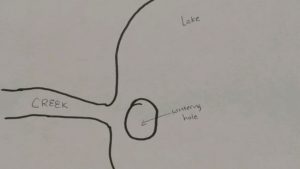
Mouths of creeks/rivers and also the mouth of reservoir “fingers” tend to have these deeper wintering holes. These are locations where water temperature remains consistent throughout the winter.
Some of these wintering holes can be man-made. Such examples include sewage treatment plant warm water dump location and where power plants dump warm water. A natural warm water spring can also make for a great wintering hole.
These wintering holes are easy to locate on electronic fishfinders. As an example, a pile of 30-40 catfish stacked up on the bottom of a deep hole is easy to see on the screen.
These wintering holes are also very popular for other fish like shad, carp, panfish, and bass. Another great way to find a wintering hole is by looking at the land topography around the lake.
If you find a very steep section of shoreline, chances are very higher it is equally as steep of a drop-off in the water. Use your electronics to scan this area for the high presence of fish and bait.
In rivers, this same principle applies. A great place to find a wintering hole is downstream where a small river or creek dumps into the main river. This area will be wider, have less current, and be less affected by changes in air temperature.
In this main body, look for the first deep bend in the river after the mouth of the creek/smaller tributary. These deeper pockets of water will often be right along the bend in river and attract catfish just like a wintering hole of a reservoir would.
Winter Catfishing
Winter catfishing is a popular activity for anglers during the colder months. While catfish tend to be less active in winter, they can still be caught using various techniques. Anglers often focus on slow-moving deep waters and use bait such as live or cut baitfish, worms, or stinkbaits to attract catfish during this time. Patience and persistence are key for a successful winter catfishing outing.
Table: Catching Winter Catfish
| Aspect | Description |
|---|---|
| Water Temperature | Catfish are less active in cold water, so it’s important to find areas where they might congregate. Look for deeper holes or areas with warmer water. |
| Bait Selection | Use bait that is more appealing in colder temperatures, such as cut bait (like shad or herring), which has a strong odor. Live bait can also be effective. |
| Fishing Technique | Slow down your approach. Catfish are lethargic in cold water, so a slower bait presentation is usually more effective. |
| Location | Focus on deep wintering holes where catfish are likely to be. These include deep river bends, holes near dam tailwaters, and deep pools. |
| Time of Day | Catfish can be caught all day in winter, but the best time is often during the warmest part of the day when the water temperature may rise slightly. |
| Tackle | Use a heavier setup to handle larger winter catfish and to accommodate heavier weights needed for deeper fishing. |
| Patience | Winter catfishing often requires more patience due to the slower metabolism and reduced activity of the fish. |
| Safety | Always be mindful of weather conditions and water safety, especially in colder temperatures. |
Winter Catfish Behavior
These rules generally pertain to all species of North American catfish during the winter. You may see exceptions to these rules but these are a great place to start from in predicting catfish behavior.
Lakes
Catfish will seek out deep wintering holes near the mouths of rivers and streams as well as near on the main body near the “fingers” of reservoirs. Look for water 20+ feet deep surrounded by shallower water.
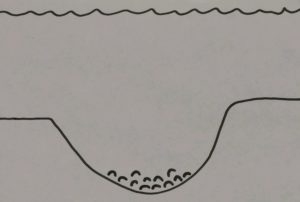
Colder Days
On days where air temperature is colder than water temperature, catfish will ball up together on the very bottom of the wintering holes.
Many times they will nestle themselves in the mud to get as far away from the cold air as possible.
You may notice dirt and mud debris on the smooth bellies of catfish you catch on cold days.
This is further confirmation these fish have been nestled in the mud on the bottom trying to escape the cold water.

Warmer Days
On days where air temperature is warmer than water temperature, catfish will move out of the deepest pockets of their watering hole and start searching for food.
On these days, warmer water can actually be found closer to the surface.
Channel cats and bullheads can be found many times on the slopes of the wintering holes in the top 2/3. Blue cats may come completely out of these holes or be suspended high in the water channel actively feeding.
Rivers
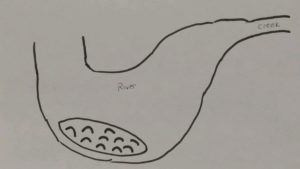
These rules apply to river catfish as well. Instead of stationary wintering holes that don’t move in lakes, there are certain deep holes associated with breaks, sunken timber or bends that will attract catfish by the dozen during the winter.
On cold days, catfish will be deep in these holes which are often 15-20 feet deep.
On warmer days, catfish can emerge from these holes and start scouring nearby flats for food. This is especially true of blue cats. They will be active during these slightly warmer times.
For a complete gear and tackle recommendation for catfish, check out my recommended catfish gear list which will help you catch more and larger catfish than anyone else.
Catching Winter Flatheads
Flathead catfish tend to shut down in the winter. They don’t completely shut off, but they enter into a semi-hibernated state. You’ll see big clusters of flatheads bunched up on the bottom of the water. They bury themselves in the mud and sleep.
However, don’t assume they are hibernating. They will feed from time to time. If you drop a bait right in the middle of a flathead semi-hibernated cluster, you can be sure one of them may take a second look at your bait. They can be fairly aware of their surroundings even when sleeping.
Water temperature fluctuations are huge factors for flathead winter activity. If water temperatures rise at all, this can cause the fish to wake up and search for food. They will still remain fairly deep in their wintering holes but they will actively hunt for prey.
Elevations in water temperature, even in ice-covered lakes, can result if large flatheads being caught. There are images only of giant flatheads being held up by ice fishermen.
Although flatheads can be active feeding in the winter, they are generally considered the least active and hardest winter catfish to catch.
To fish for winter flatheads, a 4/0 or 6/0 circle hook run through a small cut shad piece is ideal.
Table: Winter Flathead Catfish Baits
| Bait Type | Recommended Size | Effective Locations | Description |
|---|---|---|---|
| Live Bait | 4-8 inches long | Deep river bends, submerged structures, near deep holes in rivers. | Bluegills, sunfish, or shad. These should be lively and of a noticeable size to attract flatheads. |
| Cut Bait | 2-5 inches long, or golf ball-sized chunks | Deep water areas with currents, drop-offs, near underwater structures. | Freshly cut pieces of shad, carp, or suckers. Larger and fresher chunks are more effective. |
| Nightcrawlers | Full length (6-8 inches) | Banks, inlet areas, and around submerged logs or debris. | Large nightcrawlers or earthworms, used whole for maximum effect. |
| Artificial Bait | 5-10 inches long | Slower currents, deeper pools, clear water areas. | Large swimbaits or lures that mimic the appearance and movement of live fish. |
| Prepared Baits | Varies, typically 2-4 inch balls | Around cover like rock piles, fallen trees, and dock areas. | Specially formulated catfish baits. Not traditional for flathead but can be effective in some cases. |
Catching Winter Blues
On the other end of the spectrum, blue catfish are very active during the winter. In fact, some of the biggest blue cats are caught during January and February.
Blue catfish, due to their size and metabolism, have a distinct predatory advantage over most baitfish in the winter. Even on really cold days, blue cats will hunt.
In general, blue cats remain fairly active feeding all winter long. In rivers, they’ll also be the most likely to leave wintering holes and venture into shallow flats at the first sign of an increase in air temps.
Of all the catfish species, blue cats handle the cold the best and are the easiest to catch during the winter. I would argue the best time of year to catch blue cats is during the winter months.
To best fish for winter blue catfish, use large cut shad or herring with an 8/0 or 10/0 circle hook. Use a 3 oz. weight to drop the bait down deep enough.
Table: Winter Blue Catfish Baits
| Bait Type | Recommended Size | Effective Locations | Description |
|---|---|---|---|
| Shad | 3-6 inches, or whole for larger catfish | Deep channels, river bends, areas near dams, and deep holes in lakes. | Shad is a top choice for blue catfish. Use whole for larger catfish or in chunks for general use. |
| Carp | 2-4 inches, or larger sections for trophy fish | Near submerged structures and in deep water with moderate currents. | Carp, especially as cut bait, is effective due to its oily nature and strong scent. |
| Skipjack Herring | 3-5 inches, whole or in large chunks | Deep water, particularly in rivers with strong currents. | Skipjack is very appealing to blue catfish, especially in rivers. Use fresh or freshly frozen bait. |
| Chicken Livers | Golf ball-sized | Shallow areas in early winter, moving to deeper water as it gets colder. | Chicken livers are great for attracting blues due to their strong smell. Secure them well on the hook. |
| Artificial Lures | 5-8 inches | Clear water areas, near the bottom or around structures. | Large swimbaits or lures that mimic baitfish can be effective, especially in clearer waters. |
Catching Winter Channel Cats
Channel catfish are a healthy middle-ground between blue cats and flatheads in the winter. While they can be very active hunting, they are not consistently as active as blue cats who I think were designed for winter hunting.
Channel cats have the tendency to hover on the inner walls in the upper 2/3 of wintering holes when the air temperatures rise above the water temps.
They will also attack into the school of shad since they are more maneuverable than blues and flatheads. Winter channel catfish is consistently good as long as you find the proper holes.
While live bait can work for channel cats, a better option is a piece of small-cut shad with a 4/0 or 6/0 circle hook. Use a 3 oz. free-sliding weight to deliver your bait to the bottom.
Table: Winter Channel Catfish Baits
| Bait Type | Recommended Size | Effective Locations | Description |
|---|---|---|---|
| Stink Bait | Golf ball-sized or smaller | Around submerged logs, rock piles, and near inlets or outlets of lakes. | Stink baits are very effective for channel cats due to their strong smell, which attracts fish even in cold water. |
| Chicken Livers | 1-2 inches, or a small chunk | Shallow banks early in the winter, deeper areas as it gets colder. | Chicken livers are a classic choice for channel catfish, emitting a strong scent that attracts them. |
| Cut Bait | 1-3 inches | Deep holes, river bends, areas with slower current. | Cut bait like shad, herring, or sunfish works well, especially in chunk form to release more scent. |
| Nightcrawlers | Full length (6-8 inches) | Near submerged structures, in deeper pools, and along drop-offs. | Nightcrawlers are a versatile bait that can be particularly effective in smaller water bodies. |
| Artificial Baits | 3-5 inches | Clear, slow-moving waters near the bottom or around structures. | Artificial lures that mimic the appearance and movement of live fish can be effective in the right conditions. |
Catching Winter Bullheads
Bullheads, even though not a true catfish, is very similar in behavior to channel cats during the winter. They can be much more active than flatheads but usually, are reserved except when there are increases in water temperature.
A lot of ice fishermen accidentally catch bullheads on tip-ups while fishing for walleye and pickerel. Bullheads typically prefer dead or cut bait during the winter.
Like channel cats, bullheads will occupy the upper 2/3 of wintering hole walls on warmer days and bury themselves on the very bottom on colder days.
To target bullheads through the ice or from a boat, use a small circle hook with a small piece of cut shad as bait.
Winter Catfishing Tips
1. Find Warmer (Relative) Water
During the winter, locating pockets of warmer water will lead you to the fish. Catfish are desperately seeking out the warmest possible water they can find.
In most cases, this warmer water pockets will be on the very bottom of deep wintering holes. However, they can also be as a result of manmade features like power plant runoff or warm water springs.
On days where the air temperature is lower than the water temperature, catfish will emerge from these deep holes and start foraging in much shallower water.
There is no better way to locate catfish in winter than by finding warm water.
2. 15-Minute Rule
Since catfish are so concentrated during the winter, if you don’t get any bites within the first few minutes, move. Even if only 10% of the fish are hungry, that’s still plenty to see immediate action on a good wintering hole.
You can use your judgment on this one, but I would say if you don’t get any bites within the first 15 minutes, move somewhere else. Catfish do not move during the winter.
If they are not at your location, they won’t be for a very long time. Move to another spot until you find the fish. Don’t waste your time fishing 95% of the water that doesn’t hold catfish.
3. Fish Edges of Melting Ice
The winter is very hard on baitfish. Many baitfish to include shiners, shad, and minnows die-off. If you are fishing on water that gets at least partial ice cover, target the edges of the ice for big catfish.
Catfish are constantly looking for dead fish to consume during the winter since so many baitfish don’t make it. A lot of baitfish get locked up in ice for months during the winter.
As the ice starts to thaw, many of these frozen fish are released back into the water. Catfish will hover around these ice edges in early spring hoping for a freshly thawed baitfish to float away.
4. Use Cut Bait
Live bait can work well for winter catfish but cut shad seems to work a little better for most catfish varieties. Catfish are looking for dead bait now. Give them what they are looking for.
For channel and flathead cats, use smaller cut bait. Blue catfish prefer larger cut bait. To learn why I don’t recommend wasting your money on stink baits, check out this article. To learn what the best catfish baits are, check out this awesome article.
5. Long Lead Rope for Cast Net
Wintering holes attract shad and other baitfish just are much as they attract catfish. As a result, big schools of shad can down very deep.
If you want to catch them for bait, you’ll need a cast net with a 30+ foot long lead rope. Don’t be afraid to try to cats net deep bait. You’ll catch them.
6. Daytime is King
It can be argued the best time of day for summer catfish angling is night but there is no debate about winter catfish action. Daytime is your only option. This is because catfish respond best to the warmest parts of the day when it’s cold out.
7. Unhooking Pad for Bank Fishing
This is a nice extra to take with you bank fishing catfish on a river. The shoreline can be very rough, sharp, and jagged for a thrashing catfish.
They sell nice unhooking pads for a few bucks that you can wet and will provide a safe place for the fish to thrash without injuring itself. Ideal for catch and release and take-fishing if you don’t want your meat all beat up.
8. Bite Alarms
Winter catfish bites can be extremely delicate. Bite arms are ideal for solo catfish angling but especially if you are trying to keep an eye on a child or two while also monitoring multiple rod tips.
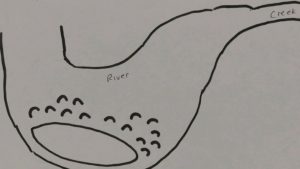
9. Shallow Flats around Holes on Warm Days
On warmer winter days, fish for catfish in the shallow flats around the deep wintering hole on a river. Blue catfish, especially, will be actively cruising these spots in search for food.
A good idea is stick to a 50-foot perimeter around the outside of the hole.
10. Warm Rain = Fish in Streams
If you see rain on the forecast, fish post-storm the shallower inlets and fingers of a reservoir. Run-off into these shallower waterways will warm up the water faster than any other single event.
Catfish will ditch their wintering holes nearby for these shallower, warmer waterways following the schools of bait.
Winter Catfishing from the Bank
Fish during the warmer parts of the day when catfish are more active. Use baits with strong scents, like cut bait or chicken livers, as catfish rely heavily on their sense of smell in colder waters. Cast your line near deep holes, river bends, or submerged structures where catfish tend to gather in winter. Patience is key, as catfish are less active and may take longer to bite in the cold.
When fishing for catfish from the bank in winter, target areas where the water is deeper and slower moving, such as near river bends, deep pools, or close to submerged structures like fallen trees or rock piles. These spots are likely to hold catfish, as they prefer stable, deeper areas during cold weather. Additionally, fishing near the mouths of tributaries or inlets can also be productive, as these locations can offer slightly warmer water and attract baitfish, which in turn draw in catfish.
To select the best catfish rod and reel, check out this helpful article written by my friend Topy Adriel.
Related Questions
Can you catch catfish with lures during winter?
It’s possible but very unlikely you’ll hook a catfish during the winter on a lure unless it is unseasonably warm out.
How do scent-baits marketed for catfish work during the winter?
These baits can work really good but since odors don’t permeate as well in colder water, they are less effective than food summer catfish. Winter catfish are also actively seeking dead baitfish so that is why I recommend cut bait.
Do catfish hibernate?
Catfish do not hibernate. They are cold-blooded creatures that can tolerate low temperatures, but they remain active throughout the year. During colder months, catfish may become less active and seek shelter in deeper, warmer waters. However, they do not enter a true hibernation state like some other animals.
Do catfish bite in the winter?
During winter, catfish tend to be less active due to the colder water temperatures. However, they can still bite if the conditions are right. Catfish may be more sluggish and prefer deeper waters during this time. Using bait with strong scents and fishing during warmer periods of the day can increase the chances of catching catfish in winter.
